Lotus Emeya VS Nissan Leaf – Specs, Efficiency & Price Comparison
Which model is the better choice – the Lotus Emeya or the Nissan Leaf? We compare performance (918 HP vs 217 HP), boot capacity (509 L vs 394 L), efficiency (18.70 kWh vs 16.70 kWh), and of course, the price (92600 £ vs 30800 £).
Find out now which car fits your needs better!
The Lotus Emeya (Hatchback) is powered by a Electric engine and comes with a Automatic transmission. In comparison, the Nissan Leaf (Hatchback) features a Electric engine and a Automatic gearbox.
When it comes to boot capacity, the Lotus Emeya offers 509 L, while the Nissan Leaf provides 394 L – depending on what matters most to you. If you’re looking for more power, you’ll need to decide whether the 918 HP of the Lotus Emeya or the 217 HP of the Nissan Leaf suits your needs better.
There are also differences in efficiency: 18.70 kWh vs 16.70 kWh. In terms of price, the Lotus Emeya starts at 92600 £, while the Nissan Leaf is available from 30800 £.
Compare all the key specs now and find out which model fits your lifestyle best!
Lotus Emeya
The Lotus Emeya represents a bold step forward for the brand, combining sleek design with cutting-edge technology. This electric vehicle offers a perfect blend of performance and luxury, capturing the essence of Lotus's heritage while pushing into the future. Its aerodynamic silhouette and plush interior ensure that both driving enthusiasts and comfort seekers will find much to admire.
details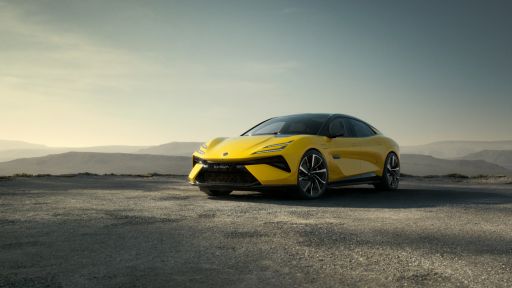 @ media.lotuscars.com
@ media.lotuscars.com
 @ media.lotuscars.com
@ media.lotuscars.com
 @ media.lotuscars.com
@ media.lotuscars.com
Nissan Leaf
The Nissan Leaf stands out as a pioneering model in the realm of electric vehicles, known for its impressive blend of practicality and eco-friendliness. It offers a smooth and quiet driving experience, making it an ideal choice for city commuting and longer journeys alike. The interior design is both comfortable and intuitive, providing drivers with a sense of modernity and ease of use.
details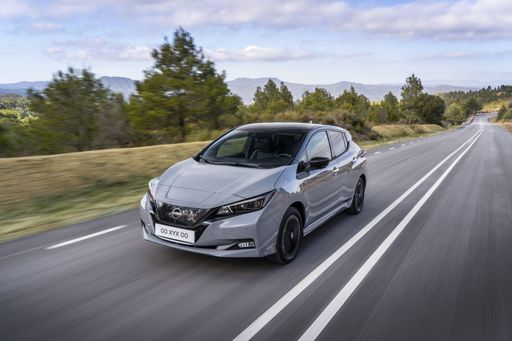 @ germany.nissannews.com
@ germany.nissannews.com
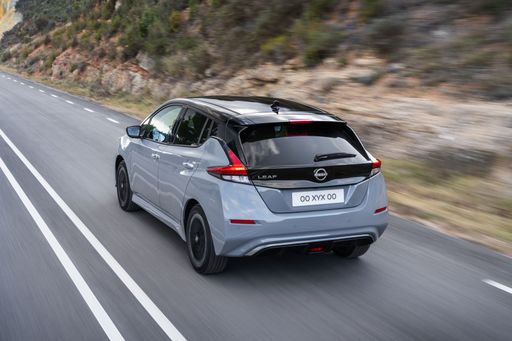 @ germany.nissannews.com
@ germany.nissannews.com
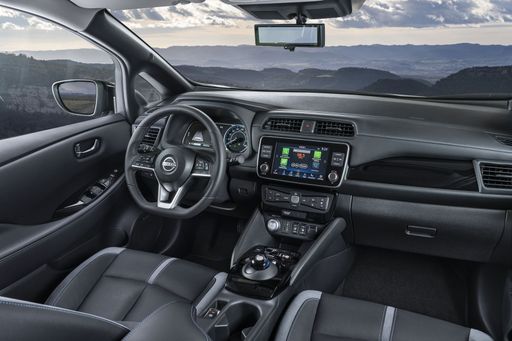 @ germany.nissannews.com
@ germany.nissannews.com
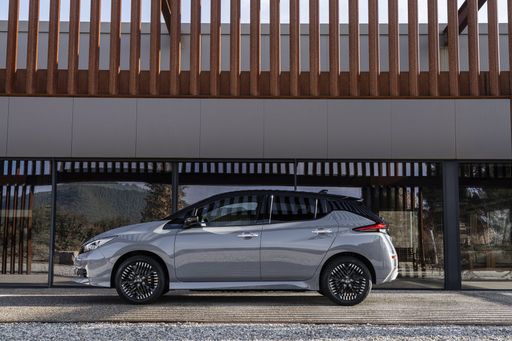 @ germany.nissannews.com
@ germany.nissannews.com

|

|
|
|
|
Costs and Consumption |
|
|---|---|
|
Price
92600 - 138000 £
|
Price
30800 - 37200 £
|
|
Consumption L/100km
-
|
Consumption L/100km
-
|
|
Consumption kWh/100km
18.7 - 22.4 kWh
|
Consumption kWh/100km
16.7 - 17.8 kWh
|
|
Electric Range
485 - 580 km
|
Electric Range
270 - 385 km
|
|
Battery Capacity
98.90 kWh
|
Battery Capacity
39 - 59 kWh
|
|
co2
0 g/km
|
co2
0 g/km
|
|
Fuel tank capacity
-
|
Fuel tank capacity
-
|
Dimensions and Body |
|
|---|---|
|
Body Type
Hatchback
|
Body Type
Hatchback
|
|
Seats
5
|
Seats
5
|
|
Doors
5
|
Doors
5
|
|
Curb weight
2555 - 2650 kg
|
Curb weight
1580 - 1756 kg
|
|
Trunk capacity
509 L
|
Trunk capacity
385 - 394 L
|
|
Length
5139 mm
|
Length
4490 mm
|
|
Width
2005 mm
|
Width
1788 mm
|
|
Height
1459 mm
|
Height
1540 - 1545 mm
|
|
Payload
450 - 545 kg
|
Payload
384 - 415 kg
|
Engine and Performance |
|
|---|---|
|
Engine Type
Electric
|
Engine Type
Electric
|
|
Transmission
Automatic
|
Transmission
Automatic
|
|
Transmission Detail
-
|
Transmission Detail
Reduction Gearbox
|
|
Drive Type
All-Wheel Drive
|
Drive Type
Front-Wheel Drive
|
|
Power HP
612 - 918 HP
|
Power HP
150 - 217 HP
|
|
Acceleration 0-100km/h
2.8 - 4.2 s
|
Acceleration 0-100km/h
6.9 - 7.9 s
|
|
Max Speed
250 - 256 km/h
|
Max Speed
144 - 157 km/h
|
|
Torque
710 - 985 Nm
|
Torque
320 - 340 Nm
|
|
Number of Cylinders
-
|
Number of Cylinders
-
|
|
Power kW
450 - 675 kW
|
Power kW
110 - 160 kW
|
|
Engine capacity
-
|
Engine capacity
-
|
General |
|
|---|---|
|
Model Year
2025
|
Model Year
2019
|
|
CO2 Efficiency Class
A
|
CO2 Efficiency Class
A
|
|
Brand
Lotus
|
Brand
Nissan
|
Lotus Emeya
A New Era for Lotus: Introducing the Emeya
The Lotus Emeya marks a bold new chapter in the illustrious history of the British automaker. As a fully electric vehicle, the Emeya not only stands as a testament to Lotus's commitment to innovation but also as a glimpse into the future of high-performance eco-friendly cars. Let's explore what sets this remarkable vehicle apart.
Sleek Design Meets Performance
With its striking fastback design, the Lotus Emeya is a masterpiece of aerodynamic efficiency and aesthetic brilliance. Its dimensions, measuring at 5139 mm in length, 2005 mm in width, and 1459 mm in height, provide a sporty yet surprisingly spacious interior accommodating up to five passengers. This elegant bodywork isn't just for show; it enhances the Emeya's capability to glide through the air with minimal resistance, contributing to its exceptional performance figures.
Power and Range: Electrifying Performance
The Lotus Emeya is available in multiple configurations, with power outputs ranging from 612 to a staggering 918 PS, demonstrating the versatility and potential of electric power. This is complemented by an impressive range of up to 610 km, making the Emeya ideal for both urban commuting and long-distance driving.
Equipped with a 102 kWh battery pack, the Emeya ensures that those thrilling drives are not limited by charging frequency. The car's all-wheel drive system, combined with a rapid 0-100 km/h acceleration in just 4.2 seconds, redefines the sporty electric vehicle experience.
Innovative Technology for Ultimate Control
Lotus has infused the Emeya with cutting-edge technology, resulting in an unparalleled driving experience. From seamless shifts provided by its automatic reduction gearbox to the advanced aerodynamic design, every technical detail in the Emeya is aimed at enhancing efficiency and enjoyment.
This advanced electric vehicle also includes various driving modes tailored for different driving conditions and preferences, empowering the driver with unparalleled control and responsiveness, whether navigating city streets or pushing limits on the open road.
Luxurious Interiors: Where Comfort Meets Craftsmanship
Stepping inside the Lotus Emeya, one is instantly greeted by an interior that embodies a sophisticated blend of luxury and modernity. The cabin is meticulously designed to offer premium comfort, with high-quality materials and state-of-the-art infotainment systems that cater to both driver and passenger needs.
Despite its high-performance capabilities, the Emeya ensures an exceptionally quiet and smooth ride, a testament to Lotus's dedication to quality and comfort. Its spacious five-door configuration further enhances practicality, making it an appealing choice for families and enthusiasts alike.
Environmental and Economic Impact
Running entirely on electricity, the Emeya emits zero CO2 emissions, securing its position as an eco-friendly alternative in the high-performance segment. Additionally, its impressive energy efficiency and cutting-edge battery technology position it favourably in terms of cost per kilometre compared to traditional combustion engines.
With prices ranging from €106,400 to €150,990, the Lotus Emeya offers various configurations that cater to different power and feature preferences, ensuring value across its line-up.
Conclusion: The Emeya Experience
The Lotus Emeya is not just a car; it's a statement of intent from Lotus. It showcases the boundless potential of electric vehicles to deliver exhilarating performance without compromising on luxury or sustainability. By blending hallmark Lotus dynamics with modern technological marvels, the Emeya is sure to leave a lasting impression on the automotive landscape.
Nissan Leaf
Introduction to the Nissan Leaf: A Pioneer in Electric Mobility
The Nissan Leaf has established itself as a trailblazer in the realm of electric vehicles (EVs) since its launch. As we delve into its present-day iterations, the Leaf continues to soar in popularity due to remarkable advancements in technology and sustainability. Let's explore what makes the Nissan Leaf a standout in today's automotive market.
Power and Performance: Under the Hood of the Nissan Leaf
The Nissan Leaf boasts a power output ranging from 150 to 217 PS, depending on the battery option chosen. The vehicle's electric motor, a product of cutting-edge engineering, offers instant torque ranging from 320 to 340 Nm, resulting in impressive acceleration capabilities. The 0 to 100 km/h dash is achieved in as little as 6.9 seconds, showcasing its prowess in electric performance.
Battery Technology: Efficient Energy Management
When discussing the Nissan Leaf, battery technology is at the forefront. The available battery capacities range from 39 to 59 kWh, supporting an electric range between 270 to 385 km. This flexibility allows drivers to choose a model that best fits their driving habits, providing peace of mind for longer journeys without frequent recharging.
Sustainability: The Environmental Edge
One of the primary attractions of the Nissan Leaf is its commitment to sustainability. As an all-electric vehicle, it produces zero CO2 emissions, placing it in the top tier of the CO2-efficiency class with an 'A' rating. This clean energy approach contributes significantly to reducing environmental impact and supports Nissan's drive towards a greener future.
Design and Comfort: Aesthetic Appeal and Practicality
The Nissan Leaf is not just about efficiency; it's also designed for comfort and utility. With its sleek hatchback body and dimensions of 4490 mm in length, 1788 mm in width, and a height of up to 1545 mm, it offers ample interior space. The boot capacity ranges from 385 to 394 litres, providing sufficient storage for everyday needs. The model accommodates five passengers comfortably, ensuring a pleasant ride for everyone.
Innovations and Safety: Advanced Features for Peace of Mind
Nissan equips the Leaf with an array of intelligent features that enhance safety and convenience. The available equipment lines, including N-CONNECTA, Tekna, e+ N-CONNECTA, and e+ Tekna, offer varying levels of technology integration. ProPILOT Assist, e-Pedal, and a comprehensive suite of driver-assistance technology are just a few examples that highlight Nissan's commitment to innovation in the EV market.
Conclusion: The Nissan Leaf Continues to Lead
With prices ranging from €35,900 to €43,400, the Nissan Leaf remains an attractive choice for those looking to embrace electric mobility. It perfectly balances performance, design, and sustainability, making it a compelling choice in the competitive EV landscape. The Nissan Leaf not only represents the future of driving but also reinforces why it continues to be a leader in the electric vehicle community.
The prices and data displayed are estimates based on German list prices and may vary by country. This information is not legally binding.
